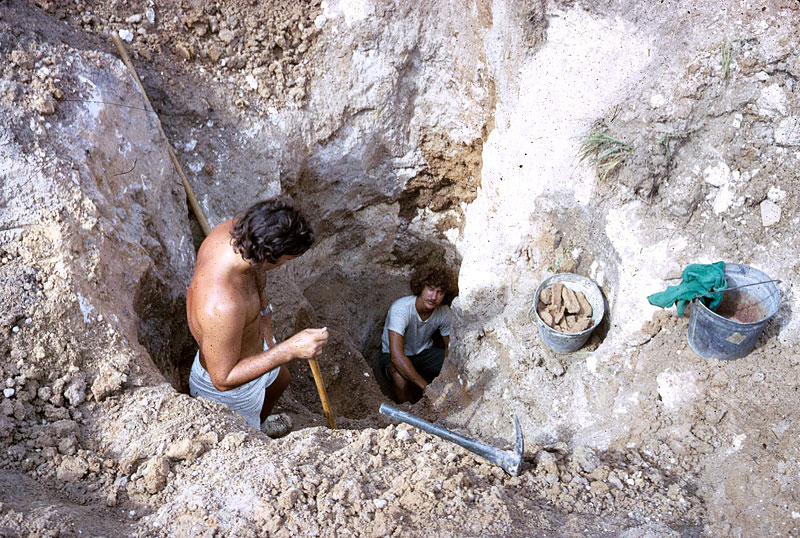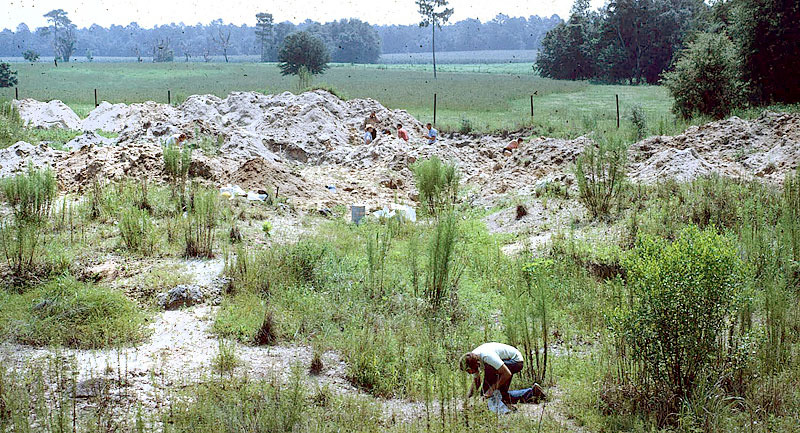McGehee Farm
University of Florida Vertebrate Fossil Locality AL027
Location
About 3 miles north of Newberry, western Alachua County, Florida; 29.7° N, 82.6° W.
Age
- Late Miocene Epoch; early Hemphillian (Hemphillian 1) land mammal age
- About 8 to 9 million years old (estimated)
Note that in the pre-1977 references cited below, the age of the site is regarded as Pliocene; Hemphillian (and Clarendonian) sites were then correlated with the Pliocene Epoch of the standard geologic time scale. As radioisotopic dating of terrestrial and marine sedimentary rocks became widespread, the correlation between the time scale and North American land mammal ages (NALMAs) was adjusted (see Hulbert, 2001).
Basis of Age
Vertebrate biochronology. The early megalonychid sloth Pliometanastes and the mylodontid sloth Thinobadistes are limited to the early Hemphillian interval (Tedford et al., 2004). The combined presence of the species Amebelodon floridanum, Neohipparion trampasense, Nannippus westoni, and Aphelops malacorhinus favor a Hemphillian 1 age instead of Hemphillian 2, as does the absence of taxa whose first appearance defines the start of the Hemphillian 2 interval: Enhydritherium, Indoarctos, and Amphimachairodus.
Geology
The fossil-bearing sediments of the McGehee Site were formerly placed in the Alachua Formation (Webb, 1964), but that geologic unit is no longer recognized by the Florida Geological Survey (Scott, 1988). The fossils from this locality occur in two distinct strata: a lower bed of poorly sorted sand and clay with small phosphatic pebbles; and an upper bed of poorly consolidated coarse sand and phosphatic and limestone cobbles (Webb, 1964). Channels of the upper bed cut into the lower deposits. These deposits lie on top of Eocene limestone. The two Miocene beds produce essentially the same fauna, so the difference in age is considered insignificant. Following deposition, numerous solution cavities and depressions formed in the underlying limestone, causing vertical slumping or collapsing of the overlying sediments by as much as 12 feet (4 meters) (Figure 1). It is impossible to determine when this karstic activity occurred; i.e. later in the Miocene, Pliocene, or Pleistocene. The late Miocene sediments are overlain by Pleistocene sands up to 2 m thick.
Depositional Environment
The McGehee site was deposited under fluvial and estuarine conditions. The lower bed was deposited by slower currents and contains abundant well-preserved fossils of nearshore marine and freshwater vertebrates. Fossils from the upper bed are generally more fragmentary and those not disturbed by slumping appear to show a preferred orientation reflecting a current direction of southeast to northwest (Webb, 1964).
Fossils

Excavation History and Methods
The site was originally discovered in 1958, but intensive excavation by the then Florida State Museum began in 1963 at the initiative of then curator Clayton Ray. The 1963-1964 excavations were supported by a grant from the Frick Corporation, and Frick field crews worked the site at times, although all specimens they collected are housed at the Florida Museum of Natural History. After 1964 the work was partially founded by NSF grant GB 3862 to S. D. Webb. Regular museum excavations ceased in June 1973, although periodic visits to spoil piles during class field trips still produced catalogable fossils for another three decades.
The site was crudely gridded into squares 10 x 10 meters in dimension. Some screen-washing of sediments was done, but no records were maintained about how much or what percentage of the site was treated in this manner. The Florida Museum of Natural History has over 3,300 cataloged specimens from McGehee Farm, plus an estimated 5,000 additional uncatalogued specimens (mostly isolated fish and turtles elements).

Discussion
McGehee Farm was the second major late Miocene vertebrate fossil site to be found in Florida, and the first to be excavated by the Florida Museum of Natural History. Its discovery showed that the Mixson’s Bone Bed site from Levy County, Florida, found in the 1880s, was not a singular occurrence. The two sites share many species, although relative abundances are different (relatively more specimens of gomphothere, rhinos, and camelids at Mixson’s; relatively more horses, tapir, and turtles at McGehee Farm) and McGehee Farm has overall greater diversity and a marine component to its fauna that is lacking at Mixson’s. Following McGehee Farm, discovery of significant late Miocene sites in north-central Florida became a regular occurrence at a frequency of about one every 15 years (if they occurred at a faster pace, our collection would have been completely filled years ago!).
The McGehee Farm site is the type locality for eight species, three aquatic turtles (Macrochelys auffenbergi, Pseudemys williamsi, and Pseudemys carri [junior synonym of Pseudemys caelata]), a small tortoise (Hesperotestudo alleni), two birds (Nycticorax fidens and Jacana farrandi), a small ground sloth (Pliometanastes protistus), and a tapir (Tapirus webbi). It also produced significant samples of garfish (Atracosteus), crocodilians (Thecachampsa americana and Alligator meffordi), rhinos (especially Teleoceras proterum), the rodent Mylagaulus kinseyi, and the horned artiodactyl Synthetoceras tricornatus.
Sources
- Original Author(s): Alexis Rojas
- Original Completion Date: November 5, 2012
- Editor(s) Name(s): Richard C. Hulbert Jr., Natali Valdes
- Last Updated On: Jnuary 16, 2022
This material is based upon work supported by the National Science Foundation under Grant Number CSBR 1203222, Jonathan Bloch, Principal Investigator. Any opinions, findings, and conclusions or recommendations expressed in this material are those of the author(s) and do not necessarily reflect the views of the National Science Foundation.
Copyright © Florida Museum of Natural History, University of Florida